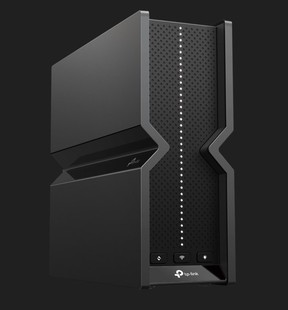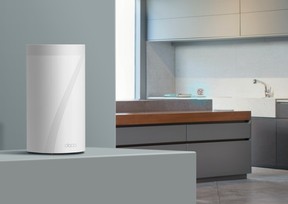SALTZMAN: I’m with the band (width)
Name the one thing all your devices in the home have in common. If you answered “Wi-Fi,” you’d be correct.
Article content
From computers and printers to smartphones and tablets to video game consoles, Smart TVs and “smart home” gadgets, wireless internet is what keeps them connected.
Article content
As such, it can be incredibly frustrating if your home Wi-Fi can’t give you the range, speed and reliability you need, especially when family members are trying to stream Netflix, play Fortnite and engage in FaceTime calls – all at the same time.
And what about those dreaded “dead zones” in your home, where (gasp!) you can’t get a signal at all.
And so, the following are five tips to improving your wireless internet.
Article content
Advertisement 3
Article content
IT STARTS WITH YOUR ISP
First things first. You could have the fastest wireless router in the world, but it won’t matter much if you aren’t getting zippy speeds from your Internet Service Provider (ISP).
Budget permitting, ensure you’re getting the fastest option offered by your ISP – or maybe it’s time to switch.
(After years of paltry 90 Megabits per second download speeds and 10 Mbps upload speeds with my ISP, the best they could deliver, I switched to another ISP offering 500 Mbps downloads and 150 uploads for the same price.)
If it’s been a few years since you’ve upgraded the modem you rent or bought from your ISP, confirm with them it’s the best one they offer – but you can do much better by buying one from a reputable home networking company.
Advertisement 4
Article content
LOCATION, LOCATION, LOCATION
“Placing your modem and router centrally within your home, especially if it’s a two-level residence, can optimize Wi-Fi coverage,” advises Aamer Captain, director of Consumer Products at TP-Link Canada, a leading home networking company. “This positioning helps ensure that the signal can reach all areas of your house more effectively, as Wi-Fi waves tend to spread in a radial pattern, similar to an umbrella opening.”
Refrain from keeping your router in the basement, if you have one, as it’ll be tough for devices elsewhere in the home to communicate with it.
On a related note, don’t lock the router away in a cabinet because you don’t like the way it looks. Instead, keep it out in the open for maximum reach. Make sure it’s off the floor and elevated, say, on a desk, table, or bookshelf.
Advertisement 5
Article content
CONSIDER A ‘MESH’ SETUP
Those in a larger home or older home (say, with concrete walls), might experience poor Wi-Fi performance in certain rooms. A “mesh” system is ideal, here, as these routers also support small “nodes” (sometimes referred to as “pods,” “bases” or “hubs”) to place around the home, to deliver fast and consistent speeds in every room.
“A mesh system presents an excellent networking option tailored for expansive residences and individuals seeking Wi-Fi connectivity across all indoor and outdoor spaces, including patios and similar areas,” Captain says. “The system seamlessly transfers signals between nodes as you move throughout the home.”
Mesh systems are modular, therefore you may buy a kit with two or three nodes to plug into the wall in various rooms, but you can always add more.
Advertisement 6
Article content
As for where to plug in the nodes, choose a location closest to those areas where you still receive a strong Wi-Fi signal.
“Avoid installing the mesh node directly in weak signal zones – instead, position it in an adjacent area with a robust signal to extend from the strongest possible connection,” Captain suggests.
In most cases, a companion app to a mesh system will tell you the optimal spot to plug in those mesh nodes, and it offers parental controls, too, such as “pausing” the Wi-Fi when you want the kids to come for dinner.

HERTZ SO GOOD
Most of today’s Wi-Fi routers broadcast in two different frequencies: 2.4 gigahertz (GHz) and 5 GHz. Figuring out the best one for your situation can improve your network’s reach, speed and reliability.
Advertisement 7
Article content
By default, some routers and mesh systems will automatically select the ideal band. If not, you can choose which frequency you prefer.
Devices on the 5 GHz frequency minimize interference among devices also operating on the 2.4Hz frequency in the home, such as microwaves, baby monitors, and cordless phones. While the 2.4 GHz frequency can reach farther distances than the 5 GHz frequency, devices connected to the 5 GHz frequency operate at faster speeds.

WI-FI 7 IS THE LATEST
If it’s time to upgrade your router, be sure to invest in a model with at least Wi-Fi 6 or Wi-Fi 6e, or better yet, one that supports the emerging Wi-Fi 7 (especially for more demanding users).
Without getting too technical, Wi-Fi 7 offers much faster throughput than the existing Wi-Fi 6 standard. We’re talking up to 46 Gigabits (Gbps) per second, along with lower latency (the amount of time it takes for a data packet to go from one place to another), and you can have more simultaneous devices running on your Wi-Fi network without impacting performance – perfect for lag-free gaming and smooth 4K streaming.
Along with the usual 2.4 GHz and 5.0 GHz band, an extra 6.0 gigahertz band ensures no interference with legacy devices.
Both supporting Wi-Fi 7, TP-Link’s latest hardware includes the Deco BE95 Mesh System and Archer BE800 router.
Also, keep your wireless router up to date with the latest downloadable “firmware.”
Article content




